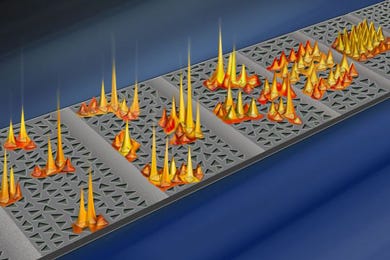Using Disarray to Create Order for Lasers, Medtech Sensors
February 3, 2015
|
This illustration from UCLA shows light traveling through a photonic crystal superlattice. The holes have been randomly patterned. The result is a narrower beam of light. |
Controlling light at nanoscale wavelengths could boost the precision of lasers and data transfer on computer chips--and improve optical communications. Researchers at UCLA and Columbia have managed to do just that, controlling light at a wavelength measuring approximately 500 nm, comparable to the wavelength of visible light itself, which ranges from about 400 to 700 nm.
The advance matters for medtech because many wearable devices use sensors that operate on optical technology. Improving the technology could also help solve data transfer and storage problems, as well as advance many of the medical devices that use optical technology, such as heart and glucose monitors.
Researchers found that they were able to control the light by using random crystal lattice structures to counteract light diffraction, according to a news release from UCLA. Researchers hope that the discovery could lead to a whole new phase in laser collimation--the science of keeping lasers precise and narrow, rather than spreading out as it propagates.
The study began as researchers looked for ways to reduce light diffraction. If a flashlight is shined against a wall, the light spreads out from the edge of the flashlight as it travels toward the wall. The closer you move the flashlight to the wall, the more the beams narrow, the further you move away from the wall, the more the beams broaden. This broadening of the light beams is known as diffraction, and has presented a problem for those trying to use light to transfer data.
Recently technology has tried to harness light as a carrier of data and information in computer chips through optical fibers. A process that can be both fast and efficient, but also difficult because when diffraction occurs, the transfer of data isn't as clean or precise as it could be. This is why researchers from UCLA and Columbia teamed up to develop a method for controlling the light used to transfer data and minimize diffraction. Researchers believe that reducing diffraction through controlling light emission could lead to advanced optical communications, as well as improving optical fibers for use in biomedicine.
As for the science behind the discovery, researchers found that to control light on the nanoscale, they needed to use a photonic crystal superlattice, a lattice structure created from crystals that can allow light to pass through. The lattice was a disorderly pattern, made up of thousands of nanoscale heptagonal, square, and triangular holes. Each hole was designed to be smaller than the wavelength of light travelling through the structure, serving as a guidepost for each beam of light.
Researchers found that structures with more disorderly patterned holes were best at trapping and collimating the beams into a narrow path, and that the structure worked over a broad part of the infrared spectrum. This method provides a new path in controlling light propagation at the wavelength scale, allowing them to deliver structure from the random disarray of the patterned holes.
Reduced diffraction could improve light emission on the nanoscale level. With medical sensors increasingly utilizing optical fiber technology, many medical devices could be enhanced by reducing diffraction through this method.
Refresh your medical device industry knowledge at MD&M West, in Anaheim, CA, February 10-12, 2015. |
Kristopher Sturgis is a contributor to Qmed and MPMN.
Like what you're reading? Subscribe to our daily e-newsletter.
About the Author(s)
You May Also Like


.png?width=300&auto=webp&quality=80&disable=upscale)
